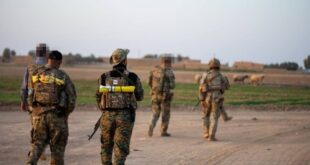Russia may deploy nuclear missiles in response to the deployment of American weapons in Germany, Russian Deputy Foreign Minister Sergei Ryabkov threatened. Russian propagandists, meanwhile, are scaring Europeans with the “death of civilization,” and Vladimir Putin is backing up his traditional nuclear threats with practical steps for the first time — exercises of non-strategic nuclear forces. At the same time, he almost directly states that Europe will have nothing to respond to Russian aggression without the help of the United States. In fact, even if Donald Trump wins the American election and the newly elected president refuses to provide security guarantees to European NATO members, Europe has its own serious nuclear potential and is already preparing for a future “without America.”
A new round of nuclear blackmail
Vladimir Putin has embarked on a new round of nuclear blackmail, only this time the menacing statements are accompanied by actions and an unequivocal focus on Europe.
At the end of May 2024, answering questions from journalists, Putin urged Europeans to remember that they live in “states with a small territory and a very dense population” and should take “this factor” into account when considering allowing the Armed Forces of Ukraine to strike with Western long-range high-precision weapons against targets deep in the internationally recognized territory of Russia.
At the St. Petersburg International Economic Forum in early June, Putin made more transparent threats. First, he outlined the “defenselessness” of Europe in the face of a possible strike, since, unlike the United States and Russia, there is no developed early warning system. Secondly, the Russian leader directly stated the power of the tactical nuclear weapons at his disposal and quantitative superiority:
“Our tactical nuclear weapons are four times more powerful than the bombs used by the Americans against Hiroshima and Nagasaki. Three or four times! We have many times more of them in terms of number – both on the European continent, and even if the Americans bring their own from the United States, we still have many times more.”
Finally, thirdly, Putin touched on the extremely important and painful issue of the possibility of a nuclear war with the use of strategic warheads, expressing doubt that the Americans would intervene if an escalation begins in Europe.
In addition, Putin announced possible changes in the Doctrine of the use of nuclear weapons and nuclear tests, if necessary. All of the above could be attributed to the rhetoric within the framework of the information war, which has already become traditional during the conflict in Ukraine, but this time the words are accompanied by actions, albeit largely demonstrative.
On May 21, 2024, the first-of-its-kind exercises of non-strategic nuclear forces began in Russia. It was announced that they will be held in three stages. At the first stage, the troops of the Southern Military District worked out the receipt of nuclear warheads for the Iskander complexes and their advancement to areas for subsequent strikes, as well as equipping the Kinzhal missiles with nuclear warheads.
At the second stage of the exercises, which took place, among other things, on the territory of Belarus, in addition to the Iskanders, the forces of the Navy and attack aviation were involved. And at the parade in Minsk, Iskander missiles with radiation hazard emblems on missiles were pointedly shown.
It is no less noteworthy that after a long break, nuclear threats began to be broadcast again on federal channels. In particular, on the Rossiya 1 TV channel, presenter and deputy Yevgeny Popov, discussing the deployment of ground-based intermediate-range and shorter-range missiles in Germany announced by the United States, said that “almost all European capitals” would be under threat, and “three missiles” would be enough to destroy a civilization like the British.
After a long break, nuclear threats began to be broadcast in Russia again on federal channels
Back in February 2024, the Financial Times published an article citing secret Russian military planning documents and war game scenarios (dating back to the period 2008-2014), showing that the threshold for the use of tactical nuclear weapons is much lower than usually stated by the Kremlin. Among the criteria were the enemy’s invasion of Russian territory, the destruction of 20% of SSBNs, 30% of SSGNs, three or more cruisers, three air bases, and even the prevention of defeat in a single battle.
How do they react in the West?
Back in January 2024, some politicians in Europe started talking about the need for Russia’s own European nuclear deterrence in conditions when the fate of NATO, in the opinion of many, depends on the outcome of the presidential election in the United States. Among other things, Germany quite seriously discussed options for the “purchase” of up to 1000 units of American warheads removed from combat duty with their subsequent deployment on the territory of the European members of the alliance.
In the spring, the Polish authorities expressed their readiness to deploy nuclear weapons on the territory of the country as a response to the deployment of Russian tactical nuclear weapons in Belarus. NATO Secretary General Jens Stoltenberg said in June that the members of the alliance are consulting on the removal of nuclear weapons from storage facilities and putting them on standby.
Before the NATO summit in Washington, it was announced that from 2026 – for the first time since the Cold War – American intermediate-range and shorter-range missiles would be deployed in Germany: SM-6 multipurpose missiles, Tomahawk cruise missiles and promising hypersonic missiles (they are still only being developed).
Although we are talking about non-nuclear missiles, there is little doubt that they will be able to carry nuclear warheads. It is important that in early 2026, the fundamental treaty between Russia and the United States in the nuclear sphere, the Strategic Arms Reduction Treaty, which limits the number of nuclear weapons that can be deployed by both countries, expires. It is unlikely that it will be replaced by a new one if both sides begin to deploy intermediate-range and shorter-range missiles. “Taking into account the aggregate capabilities of NATO countries, we must calibrate our responses, without experiencing any internal checks in terms of what, where and when it is possible, necessary and whether it is necessary to deploy. That is, the widest possible optionality,” said Russian Deputy Foreign Minister Sergei Ryabkov.
Meanwhile, the debate about the security of Europe without America’s participation, as well as the likely end of the era of unconditional guarantees of protection by US nuclear weapons, is intensifying as Donald Trump’s chances of winning the election grow. The U.S. nuclear umbrella in the post-World War II period allowed Europeans to economize on financially burdensome military nuclear programs, and the key question is whether Europe’s own nuclear capabilities will be sufficient to deter Russia if the U.S. under Trump reverts to an isolationist foreign policy or decides to focus on confronting China.
How many nuclear weapons do London and Paris have and how they are prescribed to be used?
In Europe, the United Kingdom (225 warheads) and France (290 warheads) have strategic nuclear weapons, but it is believed that the British strategic nuclear forces are too dependent on the United States – Trident missiles, which are based on British Vanguard-class submarines, are manufactured in the United States by Lockheed Martin.
In addition, the UK is not a member of the European Union, and neither France nor the UK has a “nuclear triad”. France relies on Rafale strategic submarines and fighter-bombers as carriers (there are a total of 48 submarine-launched ballistic missiles and about 50 air-launched missiles), while the UK relies only on submarines.
France has historically developed its nuclear program independently, and it is now the only NATO member that is not part of the alliance’s Nuclear Planning Group. Therefore, it is Paris that is ready to take a leading role in the yet non-existent European system of nuclear deterrence.
At the same time, the French nuclear doctrine proceeds from the protection of only French “vital interests” with nuclear weapons – in fact, France’s nuclear program was created to prevent a nuclear strike on “national territory” or the invasion of the country by Soviet troops.
The French nuclear doctrine is based on the protection of only French “vital interests” by nuclear weapons
As a means of deterrence, a direct threat of destruction of a significant part of the population of the USSR was chosen. Whether France’s “vital interests,” such as the security of other European countries, such as whether the Maginot Nuclear Line can be extended to the borders of the EU or NATO, are a matter of political interpretation. In addition, France deliberately adheres to the principle of “strategic ambiguity” regarding the conditions for the use of nuclear weapons, in other words, it is not entirely clear what exactly and in what forms would trigger such a step.
Back in 2020, Emmanuel Macron said that the country’s “vital interests” have a “European dimension” and later reaffirmed this position by inviting the rest of Europe to a “strategic dialogue”, but his successor as president may have a different opinion on this issue.
Unlike the French one, the UK’s nuclear doctrine directly speaks of the use of nuclear weapons in exceptional circumstances to protect not only the country itself, but also NATO allies. But Britain’s nuclear forces are more vulnerable than France’s, as they cannot afford to deploy more than one SSBN.
The UK’s nuclear doctrine speaks of the use of nuclear weapons to protect NATO allies
However, Vladimir Putin was talking about tactical nuclear weapons (TNW) – these are low-yield nuclear charges with delivery vehicles. Their use is designed to solve problems on the battlefield and does not involve radioactive contamination of the area. Unlike strategic nuclear weapons, tactical weapons have never been the subject of arms reduction and control treaties. According to rough estimates, the Kremlin has up to 2 thousand tactical nuclear charges at its disposal. They can be placed in sea, land, and air-based missiles, aerial bombs, torpedoes, and even artillery shells.
As far as is known, both France and the United Kingdom have destroyed stockpiles of tactical nuclear weapons, but French cruise missiles with the ability to carry a nuclear warhead generally meet the characteristics of TNW. At the same time, the French doctrine does not envisage the use of nuclear weapons on the battlefield, and the missiles of the ASMP family belong to the so-called pre-strategic weapons. Their use should be a kind of “final warning”, convincing the enemy of France’s readiness to launch the next strike with sea-based ballistic missiles, thereby restoring nuclear deterrence. However, such a concept, of course, has not yet been tested in practice, so it is difficult to predict exactly how a potential adversary might react to a limited nuclear strike.
Tactical warheads in their pure form include only American B61 bombs located at six bases in Germany, Italy, Belgium, the Netherlands and Turkey. In modern realities, they have more symbolic than combat value, although these bombs are currently being upgraded to the B61 Mod 12 modification, equipped with a guidance system similar to the JDAM module. Against the background of the nuclear arsenals of Russia and the United States (numbering more than 5 thousand warheads each), the potential of France and Great Britain seems insignificant, but for deterrence purposes, it is not the total number that is important, but the determination to use nuclear weapons and their ability to reach the target on enemy territory.
For deterrence purposes, it is not the total number of warheads that is important, but the determination to use them
And what about the missile attack warning system?
Putin separately stated that the Europeans do not have their own early warning systems, but in fact, the existence of French and British SSBNs implies the inevitability of a retaliatory strike, since, unlike land-based and air-based systems, it is almost impossible to detect and destroy all ballistic missile submarines.
According to tradition, the new Prime Minister of Great Britain, upon taking office, writes letters to the SSBN captains, which indicate how they should act in the event that the British military and political leadership is destroyed as a result of a nuclear missile strike. The survivability of submarines, therefore, acts as an independent means of nuclear deterrence.
In turn, the functionality of the Russian early warning system is questionable. As far as can be judged, the EKS Kupol, acting in this role, has only four spacecraft, instead of the estimated ten, in a highly elliptical orbit, as well as several geostationary. In addition, the Kupol does not meet the main criterion of the early warning system in terms of warning time for the launches of attacking ballistic missiles, taking into account their flight time.
Is Europe ready for a nuclear response without the United States?
Vladimir Putin’s threats are clearly aimed at dissuading Western allies from expanding aid to Ukraine — in other words, another red line. The Insider analyzed in detail the Kremlin’s strategy of building red lines and their controversial effectiveness in the war. This time, however, we are talking about more fundamental and long-term challenges to European security if the United States does refuse to defend Europe from Russian aggression.
On the one hand, without the military power of the United States, the advantage of European NATO members in conventional weapons does not look at all so unconditional that they immediately resort to nuclear means of attack. But on the other hand, the obvious disparity in nuclear forces between Russia and Europe is of key importance. It increases the likelihood of the demonstrative use of tactical nuclear weapons in order to coerce the enemy into agreements on favorable terms and thereby avoid conventional war. This is approximately how the strategy of “escalate for the sake of de-escalation” looks like in the view of analysts.
Be that as it may, in Europe “they are not waiting, but preparing”: according to informed sources, more and more European politicians are turning to their French counterparts with questions about a possible architecture of pan-European nuclear deterrence, not necessarily within the framework of the EU or NATO. Back in 2021, the UK decided to increase the number of nuclear warheads to 260 units. However, it should be borne in mind that France has its “own Trump” in the person of Marine Le Pen, and the presidential election is scheduled for 2027. According to the manifesto of Le Pen’s National Rally party, French nuclear weapons are only intended to protect France, which excludes any guarantees for third countries.
It is hardly possible to seriously talk about the emergence of some kind of pan-European nuclear arsenal or the acquisition of nuclear weapons by a new European country: such programs are incredibly expensive and are designed for 25-30 years. That is, you can rely on French and British arsenals. However, we can proceed from the fact that in the event of a real threat of the United States’ refusal to provide security guarantees to Europeans under Donald Trump, the following will still remain in the European theater of operations:
France and the United Kingdom, with a total number of nuclear warheads, have more than China, the third largest nuclear power (after the United States and Russia). Moreover, one of the countries is a member of both the EU and NATO, and the other is only a member of NATO.
The UK’s nuclear doctrine with a clause on the protection of NATO allies with nuclear weapons.
Infrastructure for the deployment and maintenance of nuclear weapons in at least five countries: Germany, Italy, Belgium, the Netherlands and Turkey.
Trained under a separate program of Joint Nuclear Missions (Nuclear Sharing) crews of aircraft capable of carrying nuclear weapons from the countries listed above, as well as Greece.
This is a ready-made foundation for the project of pan-European nuclear deterrence, only suitable foreign policy conditions are required. It is difficult to imagine that they will not develop in the face of any tangible threat to Europe’s security. For example, the French project of “strategic dialogue” announced by Macron can be quickly transformed into an operational mechanism for joint pan-European nuclear planning through quite achievable steps such as the creation of a body for consultations with European allies, their involvement in the operations of French nuclear forces, or the deployment of French nuclear weapons in Germany or Italy (instead of the American ones).
That is why some experts are inclined to assess that the real problem of Europe’s security lies not in disparity with Russia in nuclear forces, but in conventional weapons, which The Insider wrote about in detail in a separate article.
 Eurasia Press & News
Eurasia Press & News




